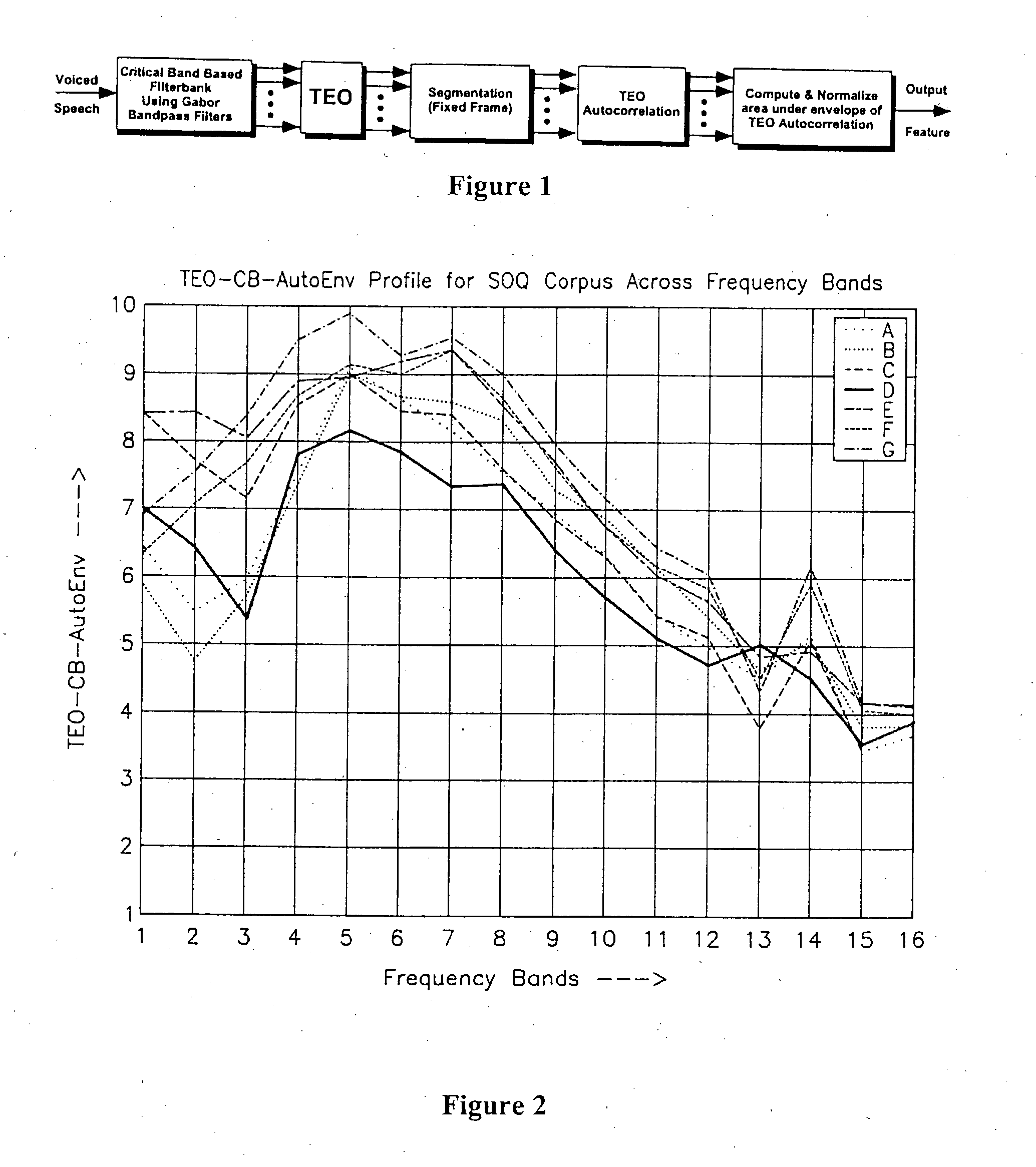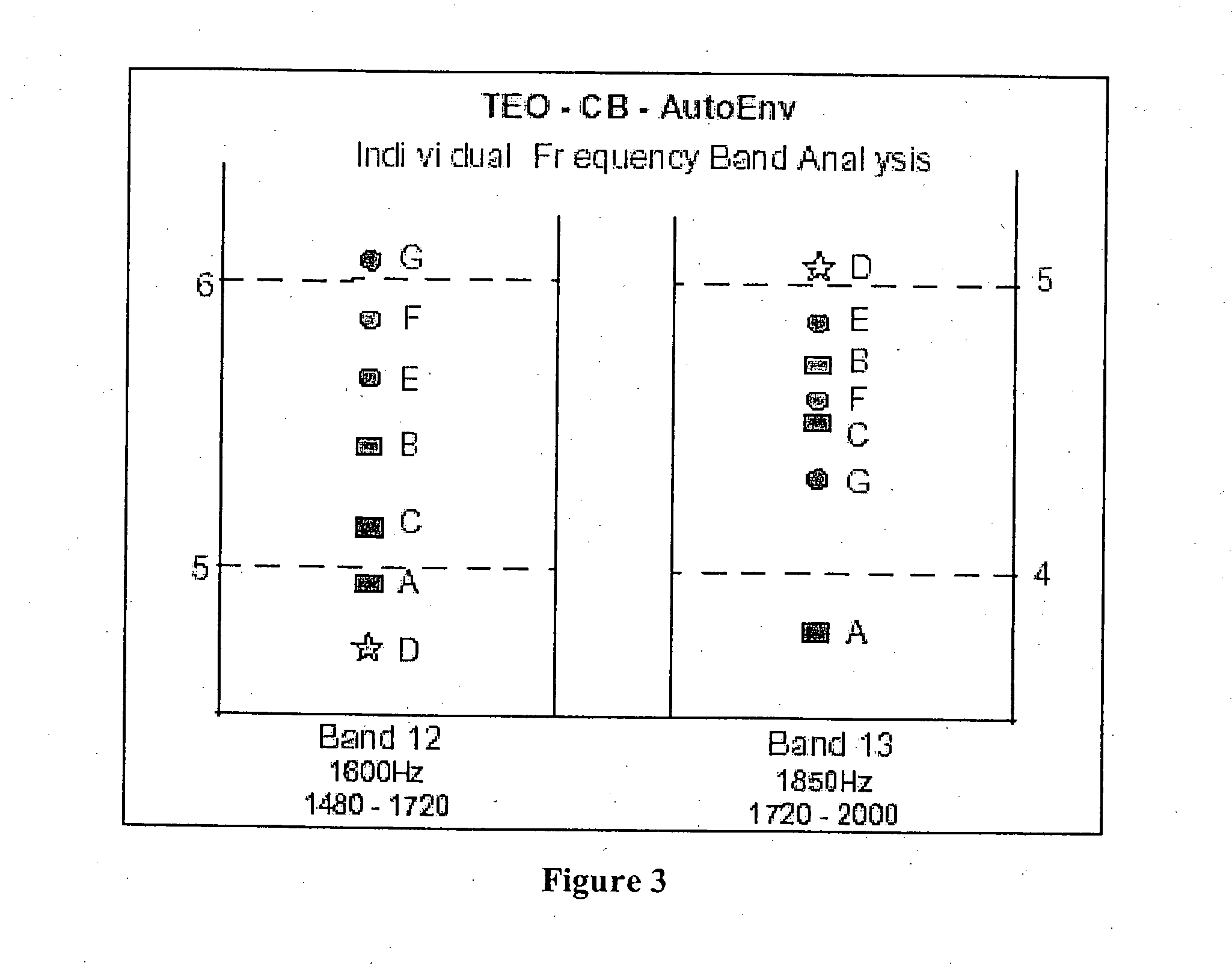Methods and systems for detecting, measuring, and monitoring stress in speech
a technology of stress and speech, applied in the field of methods and systems for detecting and measuring stress in speech, can solve the problems of significant impact of task workload and emotional stress on military speech technology, severe degradation of speech recognition algorithms, and limited military, emergency medical and psychiatric applications, etc., and achieve the effect of reducing the detection error ra
- Summary
- Abstract
- Description
- Claims
- Application Information
AI Technical Summary
Benefits of technology
Problems solved by technology
Method used
Image
Examples
example 1
Soldier of the Quarter (SOQ) Speech Corpus
[0085] A speech under stress corpus was collected at the Walter Reed Army Institute of Research (WRAIR). The speech corpus was constructed using the WRAIR Soldier of the Quarter (SOQ) Board paradigm, by recording the spoken response of individual soldiers to questions in a neutral setting, as well as while seated in front of a military evaluation board, wherein all board members had military rank much above the soldier who faced the panel). See Meyerhoff, J. L., et al. (1987) The Hypothalamic-Pituitary-Adrenal Axis Revisited: Annals of the New York Academy of Sciences, ed. by W. F. Ganong, M. F. Dallman and J. L. Roberts, 512:494-495; Meyerhoff, J. L., et al. (1988) Psychosomatic Medicine 50(3):295-303; and Oleshansky, M. A. and Meyerhoff, J. L. (1992) Stress Medicine 8:175-179, which are herein incorporated by reference.
[0086] The SOQ paradigm is a robust, repeatable, ethical and well-characterized stress model, and coupled quantitative p...
example 2
HMM Baseline Classification System
[0096] A baseline Hidden Markov Model (HMM) system was formed using the SOQ corpora of Example 1. Acoustic models comprised three state HMM's each with two Gaussian mixtures. A total of 191 tokens were used for training the neutral model, while 30 tokens were used for training the stress model in a traditional round robin manner. The front-end feature consists of a sixteen dimensional TEO-CB-AutoEnv vector. The speech data obtained during the SOQ Board scenario was assumed to be “Stress” and the remaining speech data was grouped together as “Neutral” based upon biometric results. Thus, two HMM models termed “Neutral” and “Stress” result after the training phase. Using the entire critical band TEO-CB-AutoEnv feature, a round-robin open error classification rate was found to be 22.5% for stress and 13% for neutral.
[0097] These studies have shown that the range of area coefficient values does vary depending on the type of stress. Neutral speech alway...
example 3
HMM for Frequency Band Analysis
[0098] For frequency band analysis, a second HMM classification system was trained with a front-end feature made up of the TEO-CB-AutoEnv of each individual band, forming an independent system. A separate Neutral and Stress model, was therefore constructed for every band. In addition to single band neutral and stress models, models using the first four bands (1-4), bands 5-8, and the last four bands (12-16) grouped together were trained, thereby providing thirty-two single band models, sixteen of which are neutral and sixteen under stress. An additional six four-band models were trained and classified in a similar manner.
[0099] Available speech data was partitioned into training, development-test, and test data. After an initial training phase, the development test data was used to determine which frequency bands were most sensitive to neutral and which were most sensitive to stress. In the evaluations performed, the same filter bands were selected f...
PUM
 Login to View More
Login to View More Abstract
Description
Claims
Application Information
 Login to View More
Login to View More - R&D
- Intellectual Property
- Life Sciences
- Materials
- Tech Scout
- Unparalleled Data Quality
- Higher Quality Content
- 60% Fewer Hallucinations
Browse by: Latest US Patents, China's latest patents, Technical Efficacy Thesaurus, Application Domain, Technology Topic, Popular Technical Reports.
© 2025 PatSnap. All rights reserved.Legal|Privacy policy|Modern Slavery Act Transparency Statement|Sitemap|About US| Contact US: help@patsnap.com



